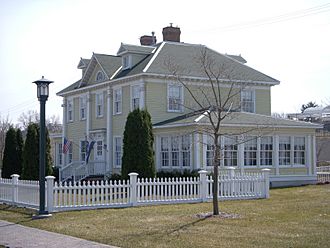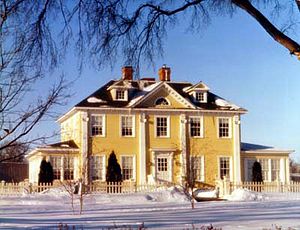Longfellow House facts for kids
The Longfellow House in Minneapolis, Minnesota, United States, is a smaller copy of Henry Wadsworth Longfellow's home. His original home is in Cambridge, Massachusetts. This house was built in 1907. Henry Wadsworth Longfellow himself never saw or lived in this house. He had passed away in 1882. Instead, it was the home of a businessman from Minneapolis named Robert "Fish" Jones. He greatly admired Longfellow. Today, the Longfellow House is located inside Minnehaha Park. It is an important part of the historic Minnehaha Park area.
The House's First Owner
Robert "Fish" Jones was a businessman in Minneapolis. In 1885, he sold his fish market. He then decided to build a zoo. This first zoo was located where the Basilica of St. Mary stands today.
Later, he moved his zoo a few miles south. It was next to the Minnehaha Creek. He rebuilt his zoo and called it the Longfellow Zoological Gardens. It opened in 1907. At the same time, he built a house for himself. He designed it to look like Henry Wadsworth Longfellow's home. It was a yellow house with porches on both ends. Robert "Fish" Jones lived there for 23 years. He closed the zoo because people living nearby complained. He agreed to give his house to the City of Minneapolis. However, he passed away in 1930 before this could happen.
Becoming a Community Library
After Robert "Fish" Jones died, the house was empty for four years. Then, the Park Board received the house. They offered it to the Minneapolis Public Library. The library bought the house for $1,500. Local residents helped raise $500 of that money.
The Works Progress Administration (WPA) helped change the house into a library. The WPA was a government program that created jobs during the Great Depression. The Longfellow Community Library opened in 1937.
The library served the southeastern part of Minneapolis very well. But in the 1950s, television became very popular. This caused fewer people to visit the library. The number of adults visiting dropped by half. Even so, the library kept going strong. In 1967, the Library Board decided to build a new library nearby. This new library was in the Wenonah neighborhood. In 1968, the Longfellow Library closed. The new Nokomis Community Library opened. It immediately had twice as many visitors as the Longfellow Library.
The House Today
After the library closed, the Longfellow House started to fall apart. In the early 1980s, it was used for a fun Halloween event. Groups like the March of Dimes and Minneapolis Jaycees turned it into a "Ghost Manor."
In 1994, a big road project was happening. This was the expansion of Hiawatha Avenue. The house had to be moved to its current spot. The Minnesota Department of Transportation worked with Ernst Movers to move the house. It was moved across the highway. This reconnected it with Minnehaha Park. The house had been separated from the park by the highway. After the move, Kodet Architectural Group renovated the house. The way they moved the house was so good that the Federal Highway Administration gave them an award.
In 2001, the Longfellow House opened again. It is now an interpretive information center. The Park Board runs it. Visitors can learn about the history of the house and the area.



